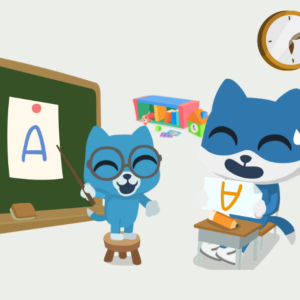Read these 6 ways to internalize learning!
Why do students forget, and what can we do about it? Learn what happens in the brain that makes information disappear, and how you can create lessons that stick for your students.

Making it Stick: 6 Ways to Review, Refresh, and Internalize Learning
You’ve spent an entire afternoon planning the perfect lesson for your students, and the result is marvelous—you’ve hit all of the objectives, your students are engaged, and you can almost see those new neural pathways forming in their brains. You walk out of class at the end of the day with a spring in your step: you’ve done your job. You taught, and your students learned.
Within the hour, though, most of your students will have forgotten 56% of what they learned in your class. In a day, they’ll have forgotten 66%. And by this time next week, they won’t remember 75% of what you taught them in that glorious lesson.
But don’t take it personally. This disheartening phenomenon is called the forgetting curve, and it describes the experiences of learners in every class—not just yours.
So what can we do?
Fighting the forgetting curve is nothing new to educators. Mnemonic devices, rote memorization practices, and pop quizzes have been around for ages—and they’re all designed to combat the learning brain’s tendency to forget.
If we pause to think about that, though, does it really make sense to fight against the brain during the learning process? Instead of fighting the process of forgetting, perhaps we should be supporting the process of remembering.
In order to do this effectively, we first need to understand what’s happening in the brain when it receives new information.
The initial process of learning something new is called encoding: your brain perceives novel information and stores it temporarily in your working memory, while it waits to decide what you’ll do with it.
Your working (or short-term) memory takes up quite a bit of your immediate attention, so the amount of information—and the amount of time it can remain there—is limited.
I like to think of this as “shopping for ice cream.” As much as I’d like to fill my grocery cart with every flavor in the freezer section, I’m limited by the space in my cart and the time I have to get it all home before it melts.
If, in that small window of time, the brain decides that this new information won’t be of any use, then it won’t bother holding onto it. “In one ear and out the other,” as they say.
But if something signals to the brain that this information is important, it moves on to the process of storage: moving the information from the working memory to the long-term memory.
Because your long-term memory doesn’t require your immediate attention the way that working memory does, it has the capacity to hold a lot more information—and to keep it for a much longer period of time. That way, much like my freezer full of ice cream at home, you can use it to begin the retrieval process at any time, and bring that information out of storage to your working memory whenever you need it.
Our brains are incredibly efficient, and they have evolved over time to organize information this way to make our lives easier. In a single day, whether we consciously realize it or not, our brains process so much new information that they have no choice but to discard most of it. If they didn’t, we’d be overwhelmed by the sheer mass of information to perceive and think about. And we’d have no way to discern what’s actually important.
The act of forgetting is an evolutionary tool that our brain has developed for an important purpose. So when it comes to the forgetting curve, we don’t actually want to stop kids from forgetting what they’ve learned—instead, we want to help them signal to their brains what’s important to remember.
To do this, we can commandeer the encoding-storage-retrieval process by adding a step of our own: consolidation.
When it comes to learning, consolidation helps to move new information from working memory into long-term memory storage. It signals to the brain that this information is worth holding onto, and makes it easier to be retrieved in the future. Read on for 6 ways to internalize learning!
Here are 6 ways that you can help students consolidate their learning, and internalize new information:
1. Don’t overload them with brand-new concepts.
Remember that working memory has a limited storage space—too much new information will overflow its capacity (just like too much ice cream will overflow my shopping cart).
No matter how important every piece of learning content might be, there’s just no way for students to remember it all at once. By trying to teach students everything you can in one lesson (even if they’re able to understand it all), you’re not helping them get ahead—you’re just making sure that they definitely miss out on something important.
Give your students plenty of time to understand, explore, and practice new skills before moving on to the next new topic. And, whenever you can, try to combine new concepts with the things they’ve already learned to help boost their memory even more.
2. Teach them to summarize, then synthesize, new knowledge.
Storage and retrieval of information can’t happen without having a deep understanding of the information in the first place. If we want students to remember what we’ve taught them, we first need to ensure that they’ve learned it well.
You probably already know the value of teaching your students to summarize what they’ve learned; not only does it serve as a formative assessment for you, but it also helps them to figure out and express their own level of understanding.
But to really make sure the information sticks, you can take this a step further by asking students to synthesize their new understanding. Synthesis is the act of combining multiple ideas together, which can be challenging—but it is the ultimate test in comprehension.
Many teachers use exit tickets, journal prompts, or discussion questions to encourage synthesis at the end of a lesson. You might have students apply their new math skills to a real-life problem, reflect on how a historical event is relevant to today’s world, or create their own follow-up hypothesis after completing an experiment.
3. Help them make connections.
One of the most efficient ways to signal to the brain that it should hold onto a certain piece of information is to make a connection to something familiar; in other words, to associate it with something that’s already proven its worth in their memory.
By connecting new information to something that already exists in their long-term storage, you can help make it easier to store (and later retrieve) that new knowledge.
Try prompting students to make connections between their new learning and their own lives, whether from lived experiences or from something they’ve read or seen before. If possible, connect new topics to lessons from the past—not only will this help store the new information in their long-term memory, but it will also help to keep the old knowledge fresh and easily retrievable.
4. Space out learning concepts over time.
Though we can store information in our long-term memory for a much longer period of time than we can in our working memory, we can’t necessarily remember all of that information forever. Indeed, our super-efficient brains are always hard at work getting rid of old memories that might not be useful.
In order to make sure that doesn’t happen with your students, be sure to revisit important topics throughout the school year. This way, you’re helping them signal to their brains that this information is worth keeping around—not just something to toss out after the unit exam.
Unfortunately, many curriculums are not structured with this in mind; the things we teach at the start of the school year are rarely brought up again by the end. If possible, try to reorganize your unit plans in a way that allows students to pick up where they left off on an earlier concept, or to revisit topics on a semi-regular basis. This is just one of the 6 ways to internalize learning and makes your organization simpler!
5. Approach problems from many different angles.
Repetition really can be the key to long-term memory storage, which explains why rote memorization, flash cards, and timed multiplication tests have been so widely used in education for so long.
The problem with these practices is that they are rarely fun for anyone involved—which means they don’t tap into students’ intrinsic motivation. And when students aren’t motivated to learn, it makes things much harder to remember.
Instead, try exploring concepts in multiple different ways. Not only is this more interesting than doing the same thing over and over again, but it also helps to ensure that students who might not have understood the first method have a chance to see it in a different light.
For example: Rather than teaching students one method of subtraction (and then having them practice it over and over again), write a subtraction problem on the board and ask students to find their own way of solving it. Invite several students with different methods to share their thinking with the rest of the class, and then help everyone walk through the steps of why each method worked (or didn’t).
This way, students are repeatedly solving a subtraction problem—but they’re thinking more deeply about the concept, they’re more engaged in finding a solution, and they’re motivated to solve it in their own way rather than the teacher’s. Together, all of this makes for a much more memorable learning experience.
6. Allow students to be the teachers.
Ever heard the phrase, “teaching is the best way to learn”? As it turns out, it’s not too far from the truth.
For the same reasons that summarizing and synthesizing can help students consolidate new information, explaining a concept to someone else can really advance the process of long-term memory storage.
That’s because when we teach, we’re actually expressing a multitude of information: the thing we’re trying to explain, our own individual perception of it, and the ways we think the other person might understand it.
This requires us to understand the initial concept enough to connect to it personally, and to explain it in a way that makes sense to others. It’s not always easy, but all of that work shows our brain that this is information worth having—and sharing!
You might have students re-teach concepts to one another as a review activity, or encourage them to learn about a topic on their own and then introduce it to the class. But being the teacher doesn’t have to be a huge project, either; you can fill out a piece of “homework” in advance, with some errors mixed in with some correct answers. Then, have students grade your work—and explain why you got the grade you did.
The forgetting curve is a real challenge to teachers and learners everywhere. But by understanding how the brain functions, we can structure our teaching methods to reflect real learning and set students up for long-term success.
These are just 6 ways to internalize learning with your students! What are some other ways we might have missed?


